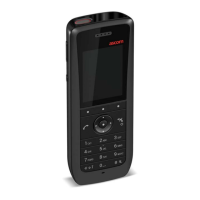TD 93119EN
28 June 2016 / Ver. PA5
User Manual
Ascom d63 DECT Handset
40
The messages that are not closed are put last in the message queue and remain in the
message queue until they are closed. They are shown as unread in the message list and are
not shown as read until they have been closed.
See Configuration Manual, Ascom d63 DECT Handset, TD 93151EN for more information
how to set the parameters.
6.6 Message Priority and Call Priority
NOTE: This feature requires settings in the WinPDM/Device Manager, see the Configuration
Manual for the handset (TD number: See
17 Related Documents on page 91).
On incoming calls, the call information dialog is always visible in front of a message by
default. The default can be overridden so that messages with a certain priority can be
displayed without being interrupted by the call. By setting a call priority, the handset
compares the call priority with the message priority to determine which information is to be
displayed, that is, the call information dialogue or the message. If the message priority and
the call priority are equal, the message is displayed.
6.7 Interactive Messaging
NOTE: The support for this feature is dependent on what model of handset that is used. For
more information, see
1.2 Functions and Accessories on page 2.
Interactive Messaging (IM) is a function that extends basic messaging. It lets a handset user
interact with a server application in the system.
An example can be machinery or equipment that can be accessed from the handset or a
personnel calling application. A list of actions can be included in the message sent from the
application to the handset.
An IM is indicated and viewed the same way as an ordinary message, see 6.3 Receive a
Message on page 35. It is saved along with other messages in the message list.
NOTE: The indication of an IM can differ from an ordinary message depending on the
settings in the IM. The application that sends the IM can determine the alert signal volume.
When an IM has been read, the IM may display several options. Mark the one required and
press “Select”. If the selected option requests input, enter the information needed and press
“Ok”. A press on the *-key changes to digit or text input mode depending on whether it is
digit or text format in the message.
A read message is indicated the same way as an
ordinary message.
NOTE: If a handset receives an IM update when the original message already has been
deleted, the handset automatically sends a negative acknowledge (NAK) to the system, if
requested.
A very simple interactive message can look like the one in figure 6 on page 41. The options
depends on the configuration in the client application.

